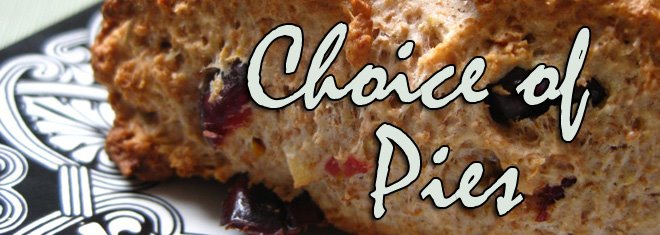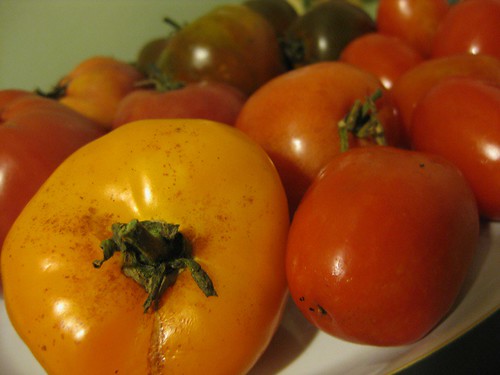 One of the best things about our CSA boxes this summer was the amazing array of heirloom tomatoes that came in August and September. My husband, Dan, is crazy about tomatoes, so most of them were eaten raw. As the weather started to cool, however, I wanted to try something a little different. I came across this roasted vegetable soup recipe while searching for a use for fennel and decided to give it shot. The method is incredibly simple and could work for almost any combination of vegetables. Basically, you roast the vegetables until soft, then puree them with some stock or broth and heat before serving. The first time I made it, I used leeks, carrots, and tomatoes, and the result was spectacular. Roasting the vegetables, rather than just boiling them, adds an incredible depth of flavor to a very simple dish. This recipe inspired me to create a new pasta sauce, which I'll describe in another post. I've since made the soup a few more times with different combinations, and it's sure to be a go-to recipe for me in the future.
One of the best things about our CSA boxes this summer was the amazing array of heirloom tomatoes that came in August and September. My husband, Dan, is crazy about tomatoes, so most of them were eaten raw. As the weather started to cool, however, I wanted to try something a little different. I came across this roasted vegetable soup recipe while searching for a use for fennel and decided to give it shot. The method is incredibly simple and could work for almost any combination of vegetables. Basically, you roast the vegetables until soft, then puree them with some stock or broth and heat before serving. The first time I made it, I used leeks, carrots, and tomatoes, and the result was spectacular. Roasting the vegetables, rather than just boiling them, adds an incredible depth of flavor to a very simple dish. This recipe inspired me to create a new pasta sauce, which I'll describe in another post. I've since made the soup a few more times with different combinations, and it's sure to be a go-to recipe for me in the future.Friday, October 31, 2008
Roasted Vegetable Soup
 One of the best things about our CSA boxes this summer was the amazing array of heirloom tomatoes that came in August and September. My husband, Dan, is crazy about tomatoes, so most of them were eaten raw. As the weather started to cool, however, I wanted to try something a little different. I came across this roasted vegetable soup recipe while searching for a use for fennel and decided to give it shot. The method is incredibly simple and could work for almost any combination of vegetables. Basically, you roast the vegetables until soft, then puree them with some stock or broth and heat before serving. The first time I made it, I used leeks, carrots, and tomatoes, and the result was spectacular. Roasting the vegetables, rather than just boiling them, adds an incredible depth of flavor to a very simple dish. This recipe inspired me to create a new pasta sauce, which I'll describe in another post. I've since made the soup a few more times with different combinations, and it's sure to be a go-to recipe for me in the future.
One of the best things about our CSA boxes this summer was the amazing array of heirloom tomatoes that came in August and September. My husband, Dan, is crazy about tomatoes, so most of them were eaten raw. As the weather started to cool, however, I wanted to try something a little different. I came across this roasted vegetable soup recipe while searching for a use for fennel and decided to give it shot. The method is incredibly simple and could work for almost any combination of vegetables. Basically, you roast the vegetables until soft, then puree them with some stock or broth and heat before serving. The first time I made it, I used leeks, carrots, and tomatoes, and the result was spectacular. Roasting the vegetables, rather than just boiling them, adds an incredible depth of flavor to a very simple dish. This recipe inspired me to create a new pasta sauce, which I'll describe in another post. I've since made the soup a few more times with different combinations, and it's sure to be a go-to recipe for me in the future.Thursday, October 30, 2008
Trip Wrap-up: Konstanz, Germany
Remember when we went to Germany in August for a wedding, and I promised to have some great food posts when we got back? Well, I failed. I got so caught up in visiting with dear friends that I haven't seen in years that I just forgot to take pictures most of the time. But it's okay; sometimes you just need to put down the camera and enjoy the moment.
I did get a lot of pictures of people, and some of places, and one decent food photo (German pastries! Hallelujah!), which deserves its own post later. So for now, here's a little photo essay to share our amazing trip with you.

We stayed in Konstanz, a beautiful old town on what the Swiss call Lake Konstanz and the Germans call the Bodensee. Konstanz also borders Switzerland and is about 45 minutes by train from the Zurich airport. We stayed at the Golden Tulip Halm, which was conveniently located across from the train station, in the Old Town, near the lake front, and a short walk from the wedding venue. The room was nicely decorated and comfortable, and the service was good, for the most part, although the concierge got snippy at check-out time when I pointed out that she had charged us for breakfast ($30 per person per day!) every day even though we hadn't eaten there at all.

We had a great time walking around the Old Town and gawking at buildings several centuries old yet integrated in to modern life. Bakeries, electronics stores, pharmacies, and even a Woolworth's are housed in and next to medieval buildings. Many of the buildings have signs like these carved in to the stucco that provide historical information (i.e. year of construction, name, and original purpose). Every sign is different and there are some really beautiful and creative designs.

Between wedding events and rambling around the Old Town, we took breaks in coffee shops like this one. This picture was taken at Aran, which is sort of the German equivalent of Starbucks. There were big, wooden tables spread with beautiful food and design books, and the coffee came steaming hot in huge, round bowls that you had to cup with your hands. I tried the German version of a bagel and schmear, which was a thick slice of dark, multigrain bread topped with three different spreads. There must have been thirty options, and since my German is not very strong, I couldn't understand many of the labels, so we picked the prettiest colors. We ended up with an avocado spread, an olive spread, and a pinkish-orange thing that turned out to be a mixture of onions and cheese. This was one of the instances when, caught up in conversation with friends who live thousands of miles away from me, I ate almost the whole thing before looking down at a few lousy bites and realizing I should have taken a picture. Oops! It was tasty, relatively cheap, and we had a good time.
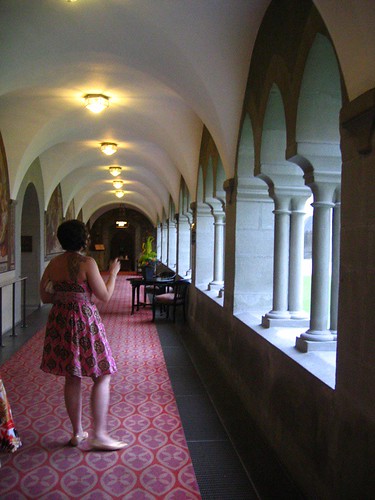
The wedding took place at the Inselhotel, a former Dominican monastery on a small private island very close to the Old Town. They have done an incredible job with the conversion, preserving as many elements of the old monastery as possible while integrating modern design elements, creating beautiful, light-filled spaces that maintain a sense of history. The reception was held in what must have been the church sanctuary, given the placement of the soaring stone columns. Fragments of frescoes punctuate the crisp white walls. The cloister, seen above, has been glassed in to create a central courtyard with a corridor running around the edge.

The day after the wedding, we all went to the bride's parents' house on the island of Reichenau. We sat for hours at the long table on their patio, surrounded by greenery (including grapevines) with views of sailboats on the lake and Switzerland beyond. We ate pastries and warm fleishkase (literally, "meat cheese," a pate-like loaf) on seed-encrusted buns. Later we grilled various types of German sausages and drank wine. In between, some people took a dip in the lake, and most of us went for a walk around the island. There's a pathway that follows the coast, and it is peppered with views like the one above.
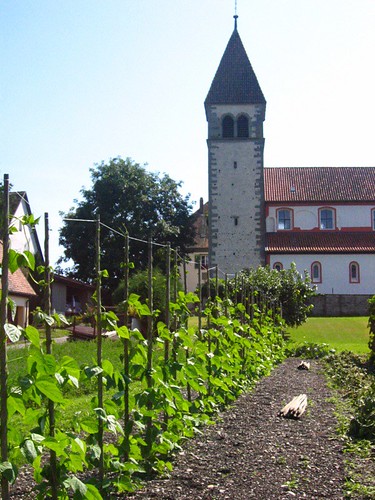
Here's another shot from the pathway: one of the three medieval churches on the island. I believe this one is the Abbey.
It's hard to believe we were only there for a few days. This was my second trip to the area and Dan's first; neither of us has been anywhere else in Germany. When I told my German client that I was going to the Bodensee for a wedding, she gasped and declared, "That's the prettiest part of Germany!" I, for one, am inclined to believe her.
I did get a lot of pictures of people, and some of places, and one decent food photo (German pastries! Hallelujah!), which deserves its own post later. So for now, here's a little photo essay to share our amazing trip with you.

We stayed in Konstanz, a beautiful old town on what the Swiss call Lake Konstanz and the Germans call the Bodensee. Konstanz also borders Switzerland and is about 45 minutes by train from the Zurich airport. We stayed at the Golden Tulip Halm, which was conveniently located across from the train station, in the Old Town, near the lake front, and a short walk from the wedding venue. The room was nicely decorated and comfortable, and the service was good, for the most part, although the concierge got snippy at check-out time when I pointed out that she had charged us for breakfast ($30 per person per day!) every day even though we hadn't eaten there at all.

We had a great time walking around the Old Town and gawking at buildings several centuries old yet integrated in to modern life. Bakeries, electronics stores, pharmacies, and even a Woolworth's are housed in and next to medieval buildings. Many of the buildings have signs like these carved in to the stucco that provide historical information (i.e. year of construction, name, and original purpose). Every sign is different and there are some really beautiful and creative designs.

Between wedding events and rambling around the Old Town, we took breaks in coffee shops like this one. This picture was taken at Aran, which is sort of the German equivalent of Starbucks. There were big, wooden tables spread with beautiful food and design books, and the coffee came steaming hot in huge, round bowls that you had to cup with your hands. I tried the German version of a bagel and schmear, which was a thick slice of dark, multigrain bread topped with three different spreads. There must have been thirty options, and since my German is not very strong, I couldn't understand many of the labels, so we picked the prettiest colors. We ended up with an avocado spread, an olive spread, and a pinkish-orange thing that turned out to be a mixture of onions and cheese. This was one of the instances when, caught up in conversation with friends who live thousands of miles away from me, I ate almost the whole thing before looking down at a few lousy bites and realizing I should have taken a picture. Oops! It was tasty, relatively cheap, and we had a good time.

The wedding took place at the Inselhotel, a former Dominican monastery on a small private island very close to the Old Town. They have done an incredible job with the conversion, preserving as many elements of the old monastery as possible while integrating modern design elements, creating beautiful, light-filled spaces that maintain a sense of history. The reception was held in what must have been the church sanctuary, given the placement of the soaring stone columns. Fragments of frescoes punctuate the crisp white walls. The cloister, seen above, has been glassed in to create a central courtyard with a corridor running around the edge.

The day after the wedding, we all went to the bride's parents' house on the island of Reichenau. We sat for hours at the long table on their patio, surrounded by greenery (including grapevines) with views of sailboats on the lake and Switzerland beyond. We ate pastries and warm fleishkase (literally, "meat cheese," a pate-like loaf) on seed-encrusted buns. Later we grilled various types of German sausages and drank wine. In between, some people took a dip in the lake, and most of us went for a walk around the island. There's a pathway that follows the coast, and it is peppered with views like the one above.

Here's another shot from the pathway: one of the three medieval churches on the island. I believe this one is the Abbey.
It's hard to believe we were only there for a few days. This was my second trip to the area and Dan's first; neither of us has been anywhere else in Germany. When I told my German client that I was going to the Bodensee for a wedding, she gasped and declared, "That's the prettiest part of Germany!" I, for one, am inclined to believe her.
Wednesday, October 29, 2008
Whoa!
Where did October go? The past few weeks have been a whirlwind of house guests and homecomings, punctuated by the health and behavioral problems of one very stubborn cat. (I think I hate going to the vet even more than she does, although when the doctor holds her down for her steroid shot, she does give a remarkable Linda Blair impression.) While I have been too caught up to post, rest assured that I never forget to eat, so I have lots of memorable meals to write about. I'll also add some more (not-even-close-to) Daily Threads, as well as a few travel posts and some reviews.
Thursday, October 9, 2008
Why We Chose a CSA
It's good for our budget. We elected both summer and winter CSAs; the summer season goes from June through October, while winter spreads from November to May. When we signed up last spring, then, we essentially pre-purchased a year's worth of vegetables. The total for both seasons came to about $500 -- this breaks down to less than $10 a week. A look at any of our weekly portions shows that we are getting a good deal here; the equivalent amount of fresh produce from our local Price Chopper would unquestionably cost quite a bit more, even if we bought the less-expensive non-organic vegetables.
It's good for our health. We selected an organic farm for our CSA; many, though not all, farms that offer CSAs follow organic practices. Among other things, organic means they don't use any chemical pesticides, so we don't have to worry about ingesting them. Also, because they don't travel as far, we receive the veggies much sooner after they are harvested. Typical grocery-store produce travels an average of two to three weeks before it is even sold. Since the nutritional value starts to decline immediately upon harvest, the sooner the produce is eaten, the better it is for your body.
Our CSA also offers a third health benefit: because we receive such a bounty each week, our vegetable consumption has gone up. While I would always buy vegetables when I went to the grocery store before, I rarely bought enough. It's too easy to get distracted by things like cereal or boxed mac and cheese. Now, every Friday, there's a boxful of veggies in our kitchen, and we are forced to consume them - or deal with the guilt of letting good veggies go to waste. Most of the time, we successfully consume (or preserve) the whole load.
It's good for our taste buds. Because these vegetables have a shorter and quicker trip from farm to table, they are fresher and more flavorful when we consume them. Also, much of the produce available in grocery stores is of varieties that are bred for durability and uniformity rather than taste. Because the veggies don't have to travel so far, our farmer can grow heirloom varieties that offer richer and more complex flavors.
It's good for our community. CSAs help farmers because they get some guaranteed income early in the year during a period when most aren't able to sell much produce. By signing up during the off-season, we provide farmers with a much-needed cash-flow injection at the hardest time of the year. They can then use the money from CSA subscriptions to buy seeds for the new crops. It also helps them judge how much to plant, because they know how much they need to produce to satisfy the CSA subscriptions.
Keeping small, family-run farms going is important to me because I appreciate the rural qualities of the area I live in. I like driving by farmland, seeing productive fields, and knowing that there are lots of places very nearby where I can go to pick berries or apples. I also like that most of my food is coming from fellow community members rather than from an enormous, impersonal, factory-style organization thousands of miles away. CSAs help farmers, but as I made clear above, CSA subscribers also benefit enormously from the relationship. This is not charity; it's good old-fashioned commerce, working in such a way that it benefits all parties involved - just as it should.
It's good for the environment. Organic farms don't use synthetic pesticides, which run off in to our rivers and seep in to our groundwater. Most small farms also rely on old-fashioned practices to keep soil productive. Rather than planting the same crop over and over on the same space, which can leech the soil of its nutrients, small farmers, who have to make the most of their limited land to survive, often practice crop rotation that allows the soil to stay productive. This means they are getting the best use out of the land.
Also, because CSAs are local in nature, they help to conserve our energy resources. Much of the produce in grocery stores has been transported thousands of miles, either by boat or truck. That requires vast amounts of oil and gasoline. Buying locally ensures that these limited resources aren't wasted. When we went to North Carolina this summer, I was flabbergasted to see only California peaches for sale. Why would you ship something from three thousand miles away when the same product was growing all around? A few days later, we made it to a nearby farmers' market, where to my delight, we found fresh North Carolina peaches. They were twice the size of the grocery-store peaches, packed with twenty times the flavor, and hadn't wasted valuable resources in getting to us.
So there you have it: my many reasons for CSA participation. There are a few downsides, which I will address in another post, but they are far, far outweighed by the benefits.
It's good for our health. We selected an organic farm for our CSA; many, though not all, farms that offer CSAs follow organic practices. Among other things, organic means they don't use any chemical pesticides, so we don't have to worry about ingesting them. Also, because they don't travel as far, we receive the veggies much sooner after they are harvested. Typical grocery-store produce travels an average of two to three weeks before it is even sold. Since the nutritional value starts to decline immediately upon harvest, the sooner the produce is eaten, the better it is for your body.
Our CSA also offers a third health benefit: because we receive such a bounty each week, our vegetable consumption has gone up. While I would always buy vegetables when I went to the grocery store before, I rarely bought enough. It's too easy to get distracted by things like cereal or boxed mac and cheese. Now, every Friday, there's a boxful of veggies in our kitchen, and we are forced to consume them - or deal with the guilt of letting good veggies go to waste. Most of the time, we successfully consume (or preserve) the whole load.
It's good for our taste buds. Because these vegetables have a shorter and quicker trip from farm to table, they are fresher and more flavorful when we consume them. Also, much of the produce available in grocery stores is of varieties that are bred for durability and uniformity rather than taste. Because the veggies don't have to travel so far, our farmer can grow heirloom varieties that offer richer and more complex flavors.
It's good for our community. CSAs help farmers because they get some guaranteed income early in the year during a period when most aren't able to sell much produce. By signing up during the off-season, we provide farmers with a much-needed cash-flow injection at the hardest time of the year. They can then use the money from CSA subscriptions to buy seeds for the new crops. It also helps them judge how much to plant, because they know how much they need to produce to satisfy the CSA subscriptions.
Keeping small, family-run farms going is important to me because I appreciate the rural qualities of the area I live in. I like driving by farmland, seeing productive fields, and knowing that there are lots of places very nearby where I can go to pick berries or apples. I also like that most of my food is coming from fellow community members rather than from an enormous, impersonal, factory-style organization thousands of miles away. CSAs help farmers, but as I made clear above, CSA subscribers also benefit enormously from the relationship. This is not charity; it's good old-fashioned commerce, working in such a way that it benefits all parties involved - just as it should.
It's good for the environment. Organic farms don't use synthetic pesticides, which run off in to our rivers and seep in to our groundwater. Most small farms also rely on old-fashioned practices to keep soil productive. Rather than planting the same crop over and over on the same space, which can leech the soil of its nutrients, small farmers, who have to make the most of their limited land to survive, often practice crop rotation that allows the soil to stay productive. This means they are getting the best use out of the land.
Also, because CSAs are local in nature, they help to conserve our energy resources. Much of the produce in grocery stores has been transported thousands of miles, either by boat or truck. That requires vast amounts of oil and gasoline. Buying locally ensures that these limited resources aren't wasted. When we went to North Carolina this summer, I was flabbergasted to see only California peaches for sale. Why would you ship something from three thousand miles away when the same product was growing all around? A few days later, we made it to a nearby farmers' market, where to my delight, we found fresh North Carolina peaches. They were twice the size of the grocery-store peaches, packed with twenty times the flavor, and hadn't wasted valuable resources in getting to us.
So there you have it: my many reasons for CSA participation. There are a few downsides, which I will address in another post, but they are far, far outweighed by the benefits.
Wednesday, October 8, 2008
potato-leek soup
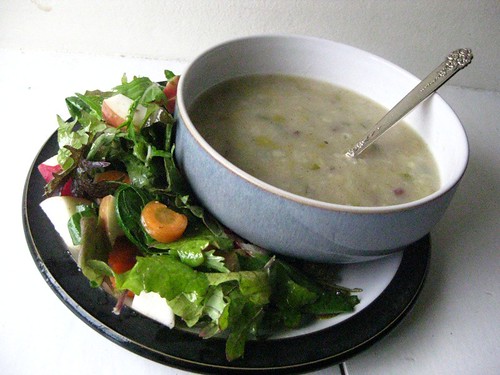
Remember the potato-leek soup in progress that I posted the other day? Here is a shot of the finished product from another batch. We had this for lunch on Saturday with a side salad of field greens, carrots, and Macintosh apples in Greek dressing.
POTATO-LEEK SOUP
2 leeks
5-6 medium russet potatoes
1 tablespoon olive oil or butter
1 can broth of your choice (I like fat-free, low-sodium chicken)
water
salt and pepper to taste
Wash the leeks thoroughly. Since dirt gets between the layers, I find the best way to do this is to cut the green part off, then slice the white part in half down the center and gently peel back the layers under running water, looking for clods of dirt. Slice the white parts thinly and saute them in butter or oil in a deep stock pot.
While the leeks are cooking, wash and thinly slice the potatoes. You can peel them first if you want, but the peel has fiber and adds a nice shot of color. Once the leeks are soft, add the potatoes and the can of broth. Add one or two cans full of water - enough to cover all the potatoes and leeks. Add chopped leek greens. Bring to a boil, then reduce heat, cover, and simmer for about 25 minutes, until potatoes are very tender. Remove from heat. Using a potato masher, break up the potatoes. If you want a really smooth soup, you could use a hand-held blender, but I prefer a slightly chunky texture. Stir to incorporate and season to taste. Makes four servings.
Tuesday, October 7, 2008
Daily Thread #2
Anthropologie is my favorite store. I say that without ever having set foot in one of their storefronts or having purchased a single garment. For years, however, it has been my virtual shopping destination of choice. If I won the lottery, along with buying a house, endowing a scholarship, and taking the whole family on a trip, one of the first things I would do is go to an Anthropologie store and buy anything that I liked, which would be damn near everything.
 This adorable pullover from Anthropologie embodies everything that I like about their clothes: it's cute, interesting, wearable, and would not look dated in a year or even five. It's quirky enough to stand the test of time and not be slaughtered by the trend wave, but there's something very classy about it, too. The angled lines, nipped waist, and slightly flared peplum would all flatter my curvy shape. It could go over a camisole in the warmer months or a longer-sleeved shirt in the winter. If it didn't cost $98, it would be in my closet right now.
This adorable pullover from Anthropologie embodies everything that I like about their clothes: it's cute, interesting, wearable, and would not look dated in a year or even five. It's quirky enough to stand the test of time and not be slaughtered by the trend wave, but there's something very classy about it, too. The angled lines, nipped waist, and slightly flared peplum would all flatter my curvy shape. It could go over a camisole in the warmer months or a longer-sleeved shirt in the winter. If it didn't cost $98, it would be in my closet right now.
Photo from Anthropologie.com.
 This adorable pullover from Anthropologie embodies everything that I like about their clothes: it's cute, interesting, wearable, and would not look dated in a year or even five. It's quirky enough to stand the test of time and not be slaughtered by the trend wave, but there's something very classy about it, too. The angled lines, nipped waist, and slightly flared peplum would all flatter my curvy shape. It could go over a camisole in the warmer months or a longer-sleeved shirt in the winter. If it didn't cost $98, it would be in my closet right now.
This adorable pullover from Anthropologie embodies everything that I like about their clothes: it's cute, interesting, wearable, and would not look dated in a year or even five. It's quirky enough to stand the test of time and not be slaughtered by the trend wave, but there's something very classy about it, too. The angled lines, nipped waist, and slightly flared peplum would all flatter my curvy shape. It could go over a camisole in the warmer months or a longer-sleeved shirt in the winter. If it didn't cost $98, it would be in my closet right now.Photo from Anthropologie.com.
Labels:
Anthropologie,
daily threads
pumpkin bread
I have an absurd love of pumpkins. As autumn rolls in and all of a sudden piles of pumpkins pop up along these country roads, I become giddy and can't help but squeal, "Look! PUMPKINS!" every time we pass a patch. To me, they are the most beautiful vegetable. I love their rotund form, their twisting stumps, and their relentlessly bold color. No wallflowers, pumpkins declare themselves proudly.
For several years, starting when I was around eight years old, I had a backyard vegetable garden. One year I grew pumpkins. I got a small crop and picked most of them, but left the largest one on the vine to get bigger. Every day I went out to check on it and decided to let it grow just a bit longer. Finally one morning I decided it was time, but when I went out to the garden, my pumpkin was gone. Fat and happy the day before, it had been attacked by slugs in the night. All that remained was the stump and a few sad, stringy seeds. It was an important lesson: patience may be a virtue, but hesitation can get you screwed.
 As much as I love pumpkins, I rarely bother with roasting them and scooping out the sweet flesh. Why go to all that trouble when the canned puree is flavorful, perfectly smooth, and cheap? I always get the plain pumpkin, not the pie mix with all its added sugars and spices, because I prefer to spice it myself and I actually rarely make pie. My three favorite things to make with canned pumpkin are pumpkin ravioli, curried pumpkin soup, and pumpkin bread.
As much as I love pumpkins, I rarely bother with roasting them and scooping out the sweet flesh. Why go to all that trouble when the canned puree is flavorful, perfectly smooth, and cheap? I always get the plain pumpkin, not the pie mix with all its added sugars and spices, because I prefer to spice it myself and I actually rarely make pie. My three favorite things to make with canned pumpkin are pumpkin ravioli, curried pumpkin soup, and pumpkin bread.
I made the season's first batch of pumpkin bread last Friday using the recipe from my circa 1970 Betty Crocker cookbook, which I picked up in a thrift store just before moving in to my first apartment. The recipe, which uses one 15oz can or half a large can of pumpkin, makes two 8" loaves. The bread is so irresistible that the two of us could easily go through a whole loaf in a day or two, so I split the batter among four mini loaf pans and freeze some. Later in the season we can pull one out of the freezer at night and have it ready for breakfast in the morning.
For several years, starting when I was around eight years old, I had a backyard vegetable garden. One year I grew pumpkins. I got a small crop and picked most of them, but left the largest one on the vine to get bigger. Every day I went out to check on it and decided to let it grow just a bit longer. Finally one morning I decided it was time, but when I went out to the garden, my pumpkin was gone. Fat and happy the day before, it had been attacked by slugs in the night. All that remained was the stump and a few sad, stringy seeds. It was an important lesson: patience may be a virtue, but hesitation can get you screwed.
 As much as I love pumpkins, I rarely bother with roasting them and scooping out the sweet flesh. Why go to all that trouble when the canned puree is flavorful, perfectly smooth, and cheap? I always get the plain pumpkin, not the pie mix with all its added sugars and spices, because I prefer to spice it myself and I actually rarely make pie. My three favorite things to make with canned pumpkin are pumpkin ravioli, curried pumpkin soup, and pumpkin bread.
As much as I love pumpkins, I rarely bother with roasting them and scooping out the sweet flesh. Why go to all that trouble when the canned puree is flavorful, perfectly smooth, and cheap? I always get the plain pumpkin, not the pie mix with all its added sugars and spices, because I prefer to spice it myself and I actually rarely make pie. My three favorite things to make with canned pumpkin are pumpkin ravioli, curried pumpkin soup, and pumpkin bread.I made the season's first batch of pumpkin bread last Friday using the recipe from my circa 1970 Betty Crocker cookbook, which I picked up in a thrift store just before moving in to my first apartment. The recipe, which uses one 15oz can or half a large can of pumpkin, makes two 8" loaves. The bread is so irresistible that the two of us could easily go through a whole loaf in a day or two, so I split the batter among four mini loaf pans and freeze some. Later in the season we can pull one out of the freezer at night and have it ready for breakfast in the morning.
Monday, October 6, 2008
Daily Thread #1
When I started this blog, I said I would mostly focus on food in the beginning but eventually expand to other topics. Since the regular CSA season is winding down and my life is (almost) no longer dominated by what to do with all those veggies, now is a good time to branch out.
If you know me in real life, you know that one of my passions is clothing. Not necessarily fashion, per se, with its endless label obsessions, but clothing, in all its wonderful forms. I even went to grad school to study its history. As times are tight and I don't have the means to purchase or create many of the things I would like to, I'm going on a window shopping spree. In addition to continuting to write about cooking and restaurants, I'm debuting a new series for the blog called "Daily Threads." The idea is that I'll post an interesting item of clothing (just about) every day.
 For our first Daily Thread, check out this shift dress from Banana Republic. It may not look like much at first, but this is actually a very rare breed: a shift dress that works for curvy girls. As a textbook hourglass (bust and hip measurements identical, with waist exactly ten inches less), shift dresses have long been out of the question for me. They tend to make my midsection disappear under a shapeless swath of fabric. But my friend Amelia, who has a very similar build, just bought this dress and raves about it. The secret in this case is the curved bodice seams and seamed waist; unlike the usual darts, this construction, along with the knit material, allows the dress to conform to our curves rather than hiding them. And at $59.99, it's a pretty good deal.
For our first Daily Thread, check out this shift dress from Banana Republic. It may not look like much at first, but this is actually a very rare breed: a shift dress that works for curvy girls. As a textbook hourglass (bust and hip measurements identical, with waist exactly ten inches less), shift dresses have long been out of the question for me. They tend to make my midsection disappear under a shapeless swath of fabric. But my friend Amelia, who has a very similar build, just bought this dress and raves about it. The secret in this case is the curved bodice seams and seamed waist; unlike the usual darts, this construction, along with the knit material, allows the dress to conform to our curves rather than hiding them. And at $59.99, it's a pretty good deal.
photo from BananaRepublic.com
If you know me in real life, you know that one of my passions is clothing. Not necessarily fashion, per se, with its endless label obsessions, but clothing, in all its wonderful forms. I even went to grad school to study its history. As times are tight and I don't have the means to purchase or create many of the things I would like to, I'm going on a window shopping spree. In addition to continuting to write about cooking and restaurants, I'm debuting a new series for the blog called "Daily Threads." The idea is that I'll post an interesting item of clothing (just about) every day.
 For our first Daily Thread, check out this shift dress from Banana Republic. It may not look like much at first, but this is actually a very rare breed: a shift dress that works for curvy girls. As a textbook hourglass (bust and hip measurements identical, with waist exactly ten inches less), shift dresses have long been out of the question for me. They tend to make my midsection disappear under a shapeless swath of fabric. But my friend Amelia, who has a very similar build, just bought this dress and raves about it. The secret in this case is the curved bodice seams and seamed waist; unlike the usual darts, this construction, along with the knit material, allows the dress to conform to our curves rather than hiding them. And at $59.99, it's a pretty good deal.
For our first Daily Thread, check out this shift dress from Banana Republic. It may not look like much at first, but this is actually a very rare breed: a shift dress that works for curvy girls. As a textbook hourglass (bust and hip measurements identical, with waist exactly ten inches less), shift dresses have long been out of the question for me. They tend to make my midsection disappear under a shapeless swath of fabric. But my friend Amelia, who has a very similar build, just bought this dress and raves about it. The secret in this case is the curved bodice seams and seamed waist; unlike the usual darts, this construction, along with the knit material, allows the dress to conform to our curves rather than hiding them. And at $59.99, it's a pretty good deal.photo from BananaRepublic.com
Labels:
Banana Republic,
daily threads
Thursday, October 2, 2008
Smorgasboard!
 Here is a shot of that applesauce spice cake I blogged about earlier. Now that I know to build in at least eight hours for the flavor to develop, it's earned a place in my baking arsenal. This time I topped it with - what else? - cream cheese frosting.
Here is a shot of that applesauce spice cake I blogged about earlier. Now that I know to build in at least eight hours for the flavor to develop, it's earned a place in my baking arsenal. This time I topped it with - what else? - cream cheese frosting.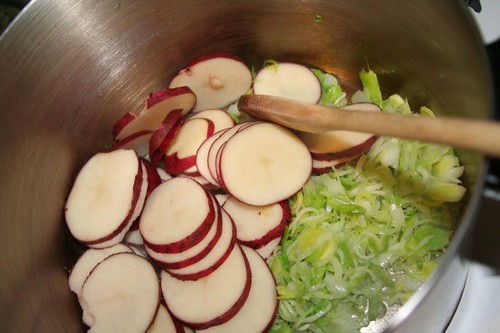 This is the beginning of a pot of potato-leek soup I made a few weeks back. It was simple, delicious, and perfect for the gray, rainy days we've been doomed with lately. No picture of the finished soup because it didn't come out well (too late for natural light - the days are getting shorter). I served it with popovers.
This is the beginning of a pot of potato-leek soup I made a few weeks back. It was simple, delicious, and perfect for the gray, rainy days we've been doomed with lately. No picture of the finished soup because it didn't come out well (too late for natural light - the days are getting shorter). I served it with popovers. Whole-wheat pancakes with walnuts, dried cranberries, and Vermont maple syrup - the perfect beginning for a Saturday. I apologize for the lousy picture quality; this was during the borrowed-camera phase and this particular camera was definitely my least favorite. I'm so glad to have my new Canon now!
Whole-wheat pancakes with walnuts, dried cranberries, and Vermont maple syrup - the perfect beginning for a Saturday. I apologize for the lousy picture quality; this was during the borrowed-camera phase and this particular camera was definitely my least favorite. I'm so glad to have my new Canon now! Kale and azuki beans is a very simple but delicious and healthy dish. Azuki beans are small, red beans popular in Japan; they are usually sold in the bulk bins at the grocery store. This dish starts with sauteing greens (in this case, fresh kale, but I've used frozen spinach many times before) with a little garlic and oil, then adding the cooked beans. I usually spritz the combo with Bragg's Liquid Aminos, but you could use soy sauce instead. Serve over brown rice and you have a tasty, nutritious, and cheap meal.
Kale and azuki beans is a very simple but delicious and healthy dish. Azuki beans are small, red beans popular in Japan; they are usually sold in the bulk bins at the grocery store. This dish starts with sauteing greens (in this case, fresh kale, but I've used frozen spinach many times before) with a little garlic and oil, then adding the cooked beans. I usually spritz the combo with Bragg's Liquid Aminos, but you could use soy sauce instead. Serve over brown rice and you have a tasty, nutritious, and cheap meal. And lastly, no food story here, but I snapped this shot at a rest stop on the way back last weekend. This is why I live in New Hampshire.
And lastly, no food story here, but I snapped this shot at a rest stop on the way back last weekend. This is why I live in New Hampshire.
Subscribe to:
Posts (Atom)
